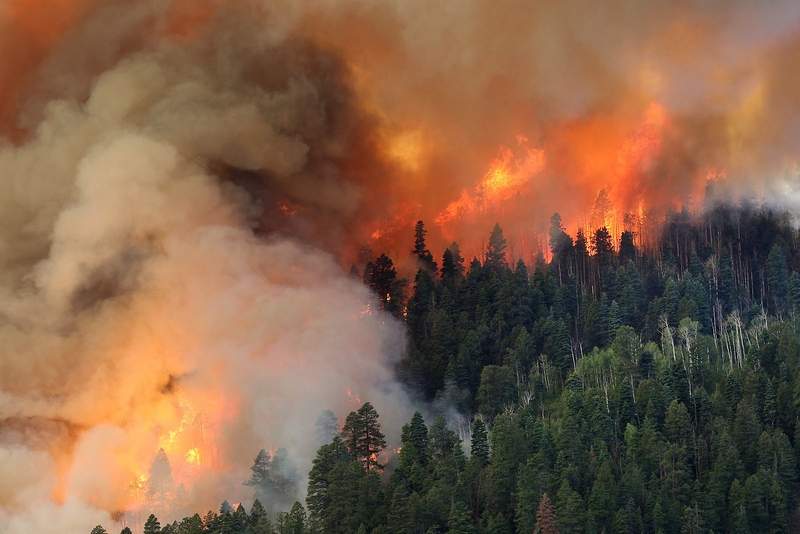Photo: Jerry McBride/Durango Herald
By Randy Scholfield
It’s hard to face reality sometimes, even when it’s staring you in the face. Even when, as at present, it’s slapping us in the face.
Gaze out across another scorched summer of drought and fires in the West, and diminished water supplies and watersheds, and tell me climate change is a hoax.
“You can ignore reality, but you can’t ignore the consequences of ignoring reality,” said a philosopher.
Some of those consequences are on full display this summer in the West. And for anglers and other river lovers, it’s a sobering new reality that we ignore at our own risk.
Southern Colorado is currently undergoing another bone-dry summer that’s shaping up to be a near-record hot season, with one-third of the region classified as in “extreme drought” or “exceptional drought.” The meager snowpack (at 37 percent of normal for the Rio Grande basin) has severely pressuredthe Rio Grande River, which likely won’t flow out of Colorado to New Mexico this year.
The Colorado River, too, and its tributaries face record drought. The North American Atmospheric Administration is forecasting that flows into Lake Powell will be 39 percent of average. A popular rainbow fishery on the Yampa River near Steamboat Springs was closedJune 10 due to low snowpack and drought. The Roaring Fork might face fishing closures later this summer due to lower flows.
Welcome to what likely is our “new normal.”
Yes, nature is always changing. But because of human-driven impacts, scientists say, we’re seeing this flux on steroids, and a pace of change that threatens to transform landscapes and ecosystems very quickly into something we might not recognize.
More and more, those changes are affecting us on a personal level.
TU’s Helen Neville told me she recently had to cancel a much-anticipated family vacation to the Durango area’s San Juan Mountains—the area was closed due to the 416 Fire, which burned some 35,000 acres, making it one of the largest wildfires in Colorado history.
Neville’s interest is personal, but also professional: As TU’s senior scientist, she sees some alarming trends playing out across the West.
“There’s no question the fires are becoming bigger and more intensive because of climate change,” says Neville. “And there are other exacerbators as well, such as bark beetles, which are becoming a bigger problem because of climate change.”
Neville told me that humans are compounding the impacts of climate, as well, by disrupting the natural landscape in multiple ways. For trout, she noted, fires are a natural and beneficial part of the ecosystem, and they’re equipped to handle them. The problem is that “we’re constricting their ability to respond to fires,” by imposing stream barriers, fragmenting watersheds, depleting flows, degrading habitat and introducing non-native fish.
These multiple stressors are tightening the noose on our favorite trout streams and rivers.
Trout Unlimited is addressing some of the threat by restoring and enhancing watersheds, reconnecting streams and rivers, providing better habitat and shade for trout, and generally making our best streams more “resilient” to the impacts of climate change.
In recent years, TU has also been enrolling agriculture producers in the System Conservation Pilot Program, which compensates farmers and ranchers for voluntary, temporary reductions in water use to boost flows into the Upper Colorado River.
That said, we shouldn’t kid ourselves about the seriousness of what we’re seeing and what it portends for the future of our trout waters.
A recent studyby the Rocky Mountain Climate Organization found that climate change was driving drought, wildfire and related impacts and, if greenhouse gases remain unchecked, Colorado’s average temperatures could jump by 7 degrees by 2055. That could put Colorado’s summer temps more in line with Tuscon’s. What will that do to our trout streams?
The reportalso forecast that by mid-century, if current emission trends continue, very large wildfires could be about 5 times more frequent across the Rocky Mountain region. And post-fire sedimentation could increase by 10 percent in the vast majority of watersheds across the West.
Meanwhile, the current administration continues to pretend that facts don’t matter, and that climate change is not a big deal. Nothing to see here. An invention of scientists. They’re even talking about shifting the missionof the National Oceanic and Atmospheric Administration—our leading climate science research agency—away from climate change.
As anglers, we are out there in the field, witnessing firsthand the stream closures and warmer waters and burned landscapes. What we’re seeing, year after year, is evidence piling up of profound changes in the air and under our feet.
But at present, I’m not sure about our individual and collective will to respond and take action. It’s human nature to stick to our ingrained habits and mindset, to resist change in our thoughts or routines, short of emergency or catastrophe.
History is strewn with the bones of civilizations that ignored the signs of reality. Do we really think we’re immune to those forces?
Randy Scholfield is TU’s director of communications for the Southwest.



